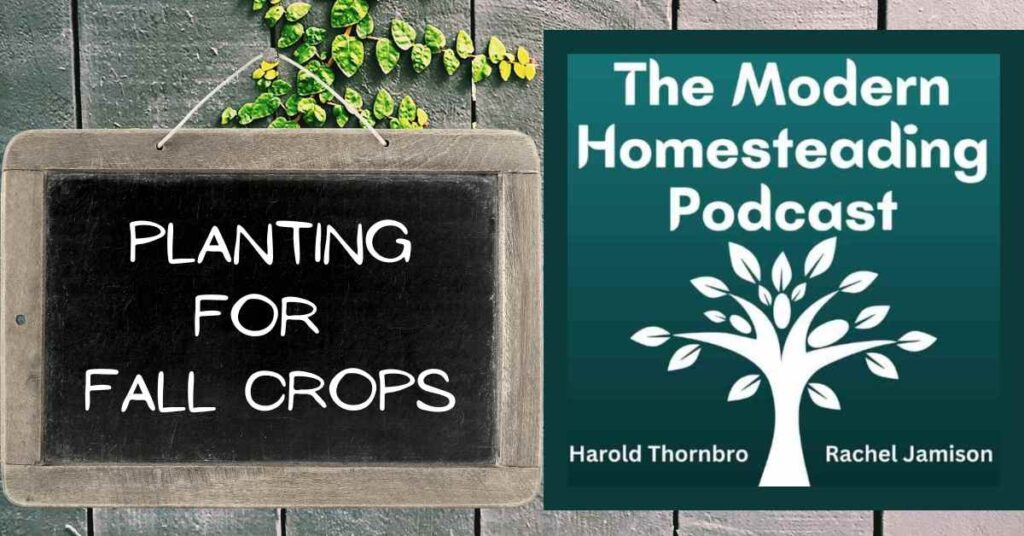
On this podcast episode, Harold has a conversation with Mary Smith from Mary’s Heirloom Seeds about Summer planting for a fall crop. They discuss how to determine when and what to plant and go over a few vegetable varieties to consider.
The Modern Homesteading Podcast, Episode 246 – June 28, 2024
Listen To The Podcast
Listen and Subscribe On Your Favorite Podcast Player
Spotify | Apple Podcasts | Amazon Music | Pandora | Pocket Casts | Castbox | Anchor | YouTube | RSS | Get Ad-Free On Patreon
Understanding Growing Zones and Frost Dates
One of the first steps in planning for fall crops is understanding your growing zone and frost dates. While USDA zones are a common reference, for annuals, your zone is less important than your frost dates. Knowing your first frost date in the fall and your last frost date in the spring is crucial. These dates help you plan when to plant your crops to ensure they mature before the cold sets in.
Soil Preparation and Crop Rotation
Soil preparation and crop rotation are key to a successful garden. Practice crop rotation to avoid planting the same crop in the same spot year after year. This helps prevent disease and pest buildup. Depending on what was previously planted, you may amend the soil with compost or specific nutrients. For example, if you planted garlic, a heavy feeder, you might add organic amendments to replenish the soil.
Selecting Fall Crops
Choosing the right crops for fall is essential. Here is a breakdown into a few different categories:
Leafy Greens
Leafy greens are excellent for fall planting. Some unique varieties include Malabar spinach and New Zealand spinach, both of which thrive in heat and provide abundant harvests. Other great options are kale, Swiss chard, and collard greens. These greens are hardy and can often withstand light frosts, making them perfect for fall.
Root Vegetables
Root vegetables are also ideal for fall gardens. Radishes, beets, turnips, and rutabagas are excellent choices. Varieties like watermelon radish and golden beets offer fun and tasty options. These crops can often be harvested both for their roots and their greens.
Brassicas
Brassicas, including broccoli, cauliflower, and cabbage, can thrive in fall gardens. Opt for faster-maturing varieties like early purple sprouting broccoli and smaller cabbages like extra dwarf Pak Choy. These crops often taste better after being exposed to a light frost.
Squash and Beans
Summer squash varieties such as white scallop squash and tromboncino squash are heat-tolerant and can be planted for fall harvests. Additionally, beans like Roma bush beans and Jade bush beans are excellent for succession planting and provide continuous yields into the fall.
Additional Considerations
Don’t forget about cover crops! Planting cover crops like alfalfa in your garden beds can enrich the soil, prevent erosion, and prepare the ground for spring planting.
Direct Sowing vs. Transplanting
Direct sowing often results in healthier, more robust plants compared to transplanting, especially in the heat of summer. Direct-seeded plants acclimate better and suffer less from transplant shock. However, for those in cooler climates or with shorter growing seasons, starting seeds indoors and transplanting may still be necessary.
Conclusion
For those interested in learning more, be sure to check out MarysHeirloomSeeds.com. Mary also offers a comprehensive planting guide on her website and goes live on YouTube every Thursday at 5 PM Central Time. You can also find her on Instagram and in the Homestead Front Porch Facebook group.
Links
- Mary’s Website: Mary’s Heirloom Seeds
- May’s YouTube Channel: https://www.youtube.com/@marysheirloomseeds
- Earlier Podcast Episode With Mary – The Difference Between GMO, Hybrid, and Heirloom Seeds




